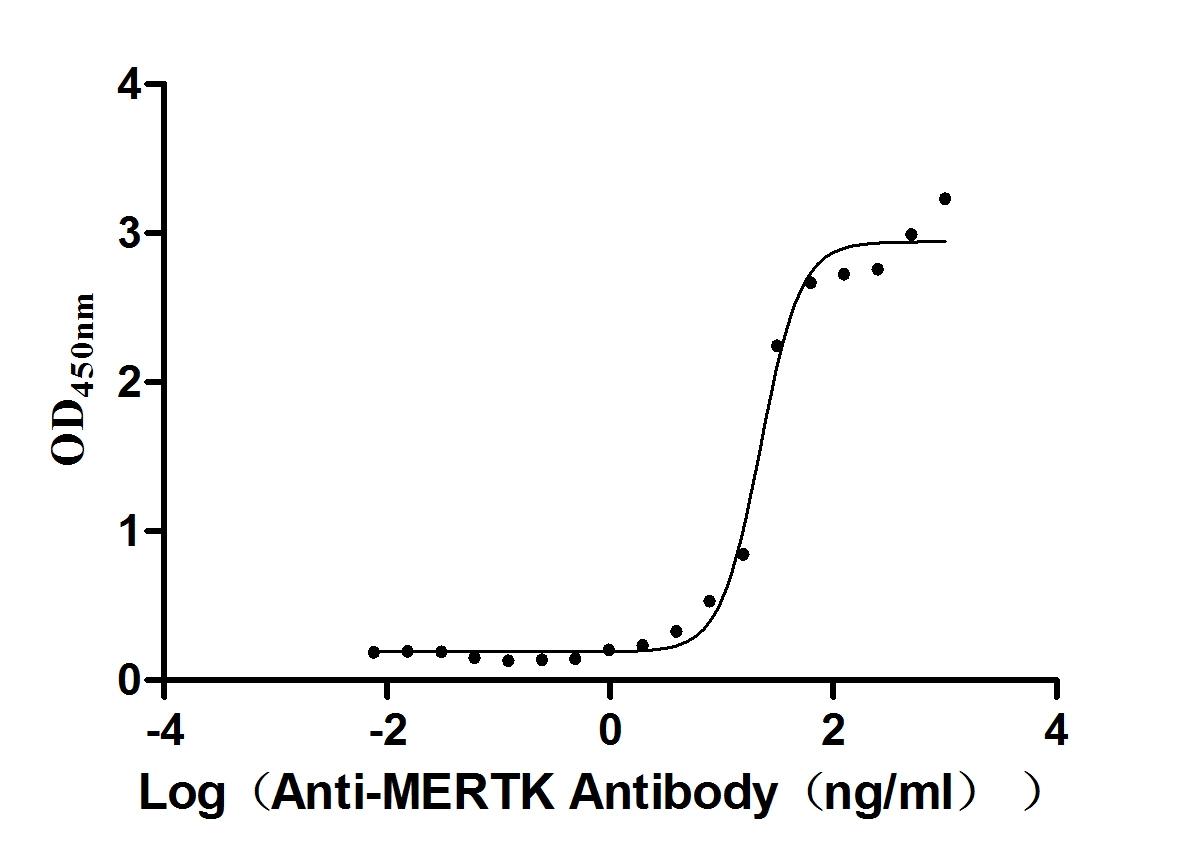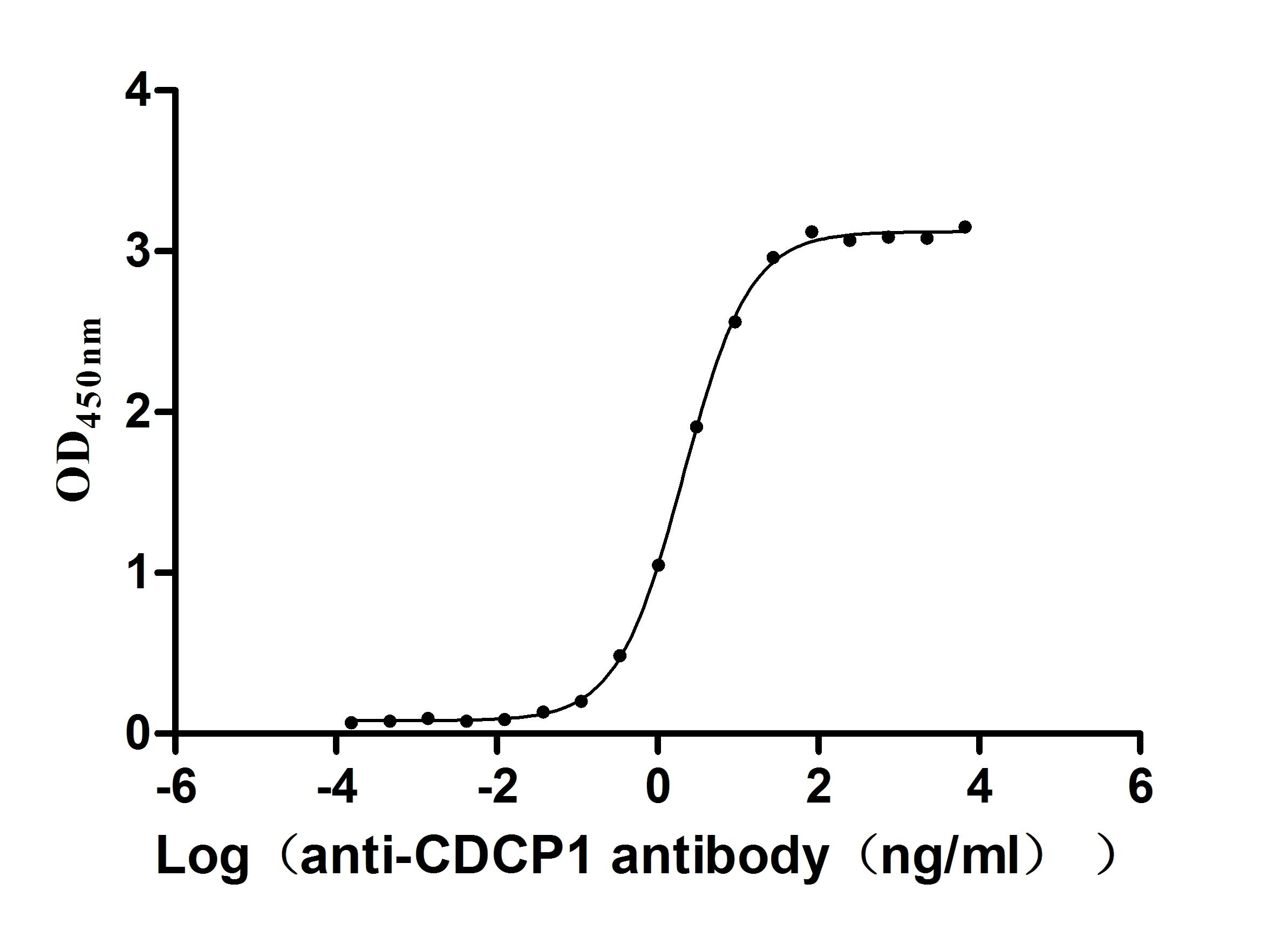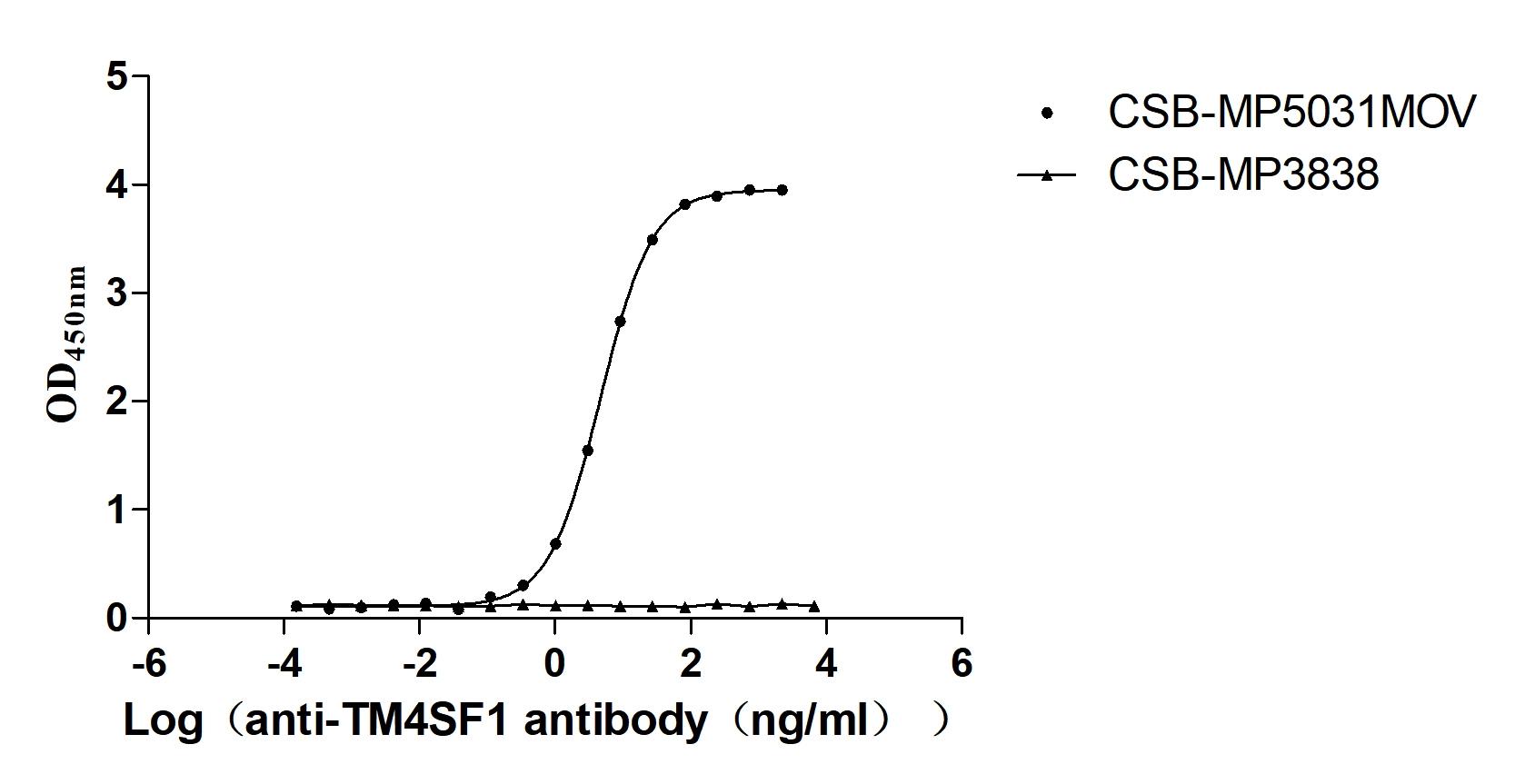Recombinant Human Ras association domain-containing protein 5 (RASSF5)
-
货号:CSB-YP819906HU
-
规格:
-
来源:Yeast
-
其他:
-
货号:CSB-EP819906HU-B
-
规格:
-
来源:E.coli
-
共轭:Avi-tag Biotinylated
E. coli biotin ligase (BirA) is highly specific in covalently attaching biotin to the 15 amino acid AviTag peptide. This recombinant protein was biotinylated in vivo by AviTag-BirA technology, which method is BriA catalyzes amide linkage between the biotin and the specific lysine of the AviTag.
-
其他:
-
货号:CSB-BP819906HU
-
规格:
-
来源:Baculovirus
-
其他:
-
货号:CSB-MP819906HU
-
规格:
-
来源:Mammalian cell
-
其他:
产品详情
-
纯度:>85% (SDS-PAGE)
-
基因名:
-
Uniprot No.:
-
别名:Maxp 1; MAXP1; MGC10823; MGC17344; New ras effector 1; NORE 1; NORE1; NORE1A; NORE1B; Novel Ras effector 1; RAP1 Binding Protein; RAPL; Ras association (RalGDS/AF 6) domain family 5; Ras association (RalGDS/AF 6) domain family member 5; Ras association domain containing family protein 5; Ras association domain-containing protein 5; Ras effector like protein; RASF5_HUMAN; RASSF 3; RASSF 5; RASSF3; RASSF5; Regulator for cell adhesion and polarization enriched in lymphoid tissue; Regulator for cell adhesion and polarization enriched in lymphoid tissues; Tumor suppressor RASSF3
-
种属:Homo sapiens (Human)
-
蛋白长度:full length of Isoform 2
-
表达区域:1-265
-
氨基酸序列MTVDSSMSSGYCSLDEELEDCFFTAKTTFFRNAQSKHLSKNVCKPVEETQRPPTLQEIKQKIDSYNTREKNCLGMKLSEDGTYTGFIKVHLKLRRPVTVPAGIRPQSIYDAIKEVNLAATTDKRTSFYLPLDAIKQLHISSTTTVSEVIQGLLKKFMVVDNPQKFALFKRIHKDGQVLFQKLSIADRPLYLRLLAGPDTEVLSFVLKENETGEVEWDAFSIPELQNFLTILEKEEQDKIQQVQKKYDKFRQKLEEALRESQGKPG
-
蛋白标签:Tag type will be determined during the manufacturing process.
The tag type will be determined during production process. If you have specified tag type, please tell us and we will develop the specified tag preferentially. -
产品提供形式:Lyophilized powder
Note: We will preferentially ship the format that we have in stock, however, if you have any special requirement for the format, please remark your requirement when placing the order, we will prepare according to your demand. -
复溶:We recommend that this vial be briefly centrifuged prior to opening to bring the contents to the bottom. Please reconstitute protein in deionized sterile water to a concentration of 0.1-1.0 mg/mL.We recommend to add 5-50% of glycerol (final concentration) and aliquot for long-term storage at -20℃/-80℃. Our default final concentration of glycerol is 50%. Customers could use it as reference.
-
储存条件:Store at -20°C/-80°C upon receipt, aliquoting is necessary for mutiple use. Avoid repeated freeze-thaw cycles.
-
保质期:The shelf life is related to many factors, storage state, buffer ingredients, storage temperature and the stability of the protein itself.
Generally, the shelf life of liquid form is 6 months at -20°C/-80°C. The shelf life of lyophilized form is 12 months at -20°C/-80°C. -
货期:Delivery time may differ from different purchasing way or location, please kindly consult your local distributors for specific delivery time.Note: All of our proteins are default shipped with normal blue ice packs, if you request to ship with dry ice, please communicate with us in advance and extra fees will be charged.
-
注意事项:Repeated freezing and thawing is not recommended. Store working aliquots at 4°C for up to one week.
-
Datasheet :Please contact us to get it.
相关产品
靶点详情
-
功能:Potential tumor suppressor. Seems to be involved in lymphocyte adhesion by linking RAP1A activation upon T-cell receptor or chemokine stimulation to integrin activation. Isoform 2 stimulates lymphocyte polarization and the patch-like distribution of ITGAL/LFA-1, resulting in an enhanced adhesion to ICAM1. Together with RAP1A may participate in regulation of microtubule growth. The association of isoform 2 with activated RAP1A is required for directional movement of endothelial cells during wound healing. May be involved in regulation of Ras apoptotic function. The RASSF5-STK4/MST1 complex may mediate HRAS and KRAS induced apoptosis.
-
基因功能参考文献:
- Ubc9 is an essential regulator of ADAP where it is required for TCR-induced membrane recruitment of the small GTPase Rap1 and its effector protein RapL. PMID: 29127148
- Hepatitis C virus uses NS5B to specifically suppress NORE1A, facilitating viral replication and elevated Ras signaling. PMID: 28090674
- Our study demonstrated that miR-214 expression was elevated and RASSF5 was down regulated in oral cancer. Moreover, miR-214 suppressed KB cell apoptosis through down regulation of RASSF5 expression PMID: 28290615
- mCD40L-induced cell death mediated by NORE1A expression appeared to be independent of mCD40L-induced cell death mediated by sustained JNK activation since NORE1A inhibition did not affect JNK phosphorylation and vice versa PMID: 26986513
- Ras induces the formation of a complex between NORE1A and the phosphatase PP1A, promoting the activation of the Rb tumor suppressor by dephosphorylation PMID: 26677227
- Down-regulation of RASSF5A and RASSF5C expression is a tumor-specific phenomenon. PMID: 25420558
- RASSF5 expression is negatively correlated with distant metastasis of osteosarcoma, and RASSF5 may function as a tumor suppressor in OS cells through activation of the MST1/LATS1 pathway. PMID: 25109282
- NORE1A allows Ras to qualitatively modify p53 function to promote senescence. PMID: 25778922
- the inactivation of RASSF5A through CpG island 1 methylation may play an important role in esophageal squamous cell carcinoma (ESCC) carcinogenesis, RASSF5A may be a functional tumor suppressor and may serve as a prognostic biomarker for ESCC. PMID: 25579665
- NORE1A has a role in Ras regulation of SCF(beta-TrCP) protein activity and specificity PMID: 25217643
- RASSF5 can act as an inhibitor or a potential positive regulator of Mst2, depending on whether it binds to Mst2 before or after activation-loop phosphorylation. PMID: 23972470
- Ubiquitin ligase Itch is a unique negative regulator of RASSF5. PMID: 23538446
- The RASSF gene family members RASSF5, RASSF6 and RASSF7 show frequent DNA methylation in neuroblastoma. PMID: 22695170
- crystal of NORE1 diffracted to 2.7 A resolution and belonged to space group P6(1)22, with unit-cell parameters a = b = 73.041, c = 66.092 A, alpha = beta = 90, gamma = 120 degrees PMID: 22750872
- These findings indicate that the control of HIPK1 stability by Mdm2-NORE1 has a major effect on cell behaviour, and epigenetic inactivation of NORE1 enables adenocarcinoma formation in vivo through HIPK1 stabilization. PMID: 22173032
- NORE1A has activity that suppresses the centrosome amplification induced by HU and that NORE1A mRNA down-regulation is one of the common gene abnormalities in NSCLCs, both of which imply a key preventive role of NORE1A against the carcinogenesis of NSCLC. PMID: 20434789
- epigenetic inactivation of NORE1 due to aberrant promoter hypermethylation is a frequent event in colorectal tumorigenesis and might be implicated in the malignant progression of colorectal tumors PMID: 20969767
- a novel regulatory network composed of the tumor suppressor NORE1A, the mitotic kinase Aurora A, the small GTPase Ras, and the microtubule cytoskeleton. PMID: 20339001
- findings define a T cell receptor "inside-out" pathway via N-SKAP1-C-RapL that regulates T cell adhesion, motility, and arrest times with dendritic cells in lymph nodes. PMID: 20346707
- The present investigation provided evidence that Lck-mediated phosphorylation regulates the nucleocytoplasmic shuttling and cell growth control activities of RASSF5. PMID: 20064523
- Nore1 is a member of a family of Ras effector/tumor suppressors that includes RASSF1 PMID: 12676952
- the epigenetic alteration of NORE1A is confined to lung tumors with a wild-type K-ras: 88% (15 of 17) of the tumors with NORE1 hypermethylation did not harbor a K-ras mutation (P=0.008, Fisher's exact test) PMID: 15378027
- Rap1 activation contributes to directional vascular endothelial cell migration accompanied by extension of microtubules on which RAPL localizes PMID: 15569673
- results indicate that RASSF1A epigenetic changes are an early event in thyroid tumor pathogenesis and progression PMID: 15980887
- Suppression of NORE1A, a known Ras effector, in PAX8-PPARgamma fusion-carrying follicular thyroid cancer. PMID: 16352687
- association of NORE1A with cytoskeletal elements is essential for NORE1A-induced growth suppression and that the ERK pathway is a target for NORE1A growth-suppressive activities PMID: 16421102
- The candidate tumor suppressor gene NORE1B is epigenetically down-regulated in hepatocellular carcinoma. PMID: 16516329
- These findings suggest that endogenous Nore1B recruits active Ras to the APC-T cell interface and mediates the interaction between Ras and Carma1. PMID: 16520020
- The NORE1A gene was never found epigenetically methylated in hepatitic or non-hepatitic liver. PMID: 16606445
- Nuclear localization of RASSF5 is critical for its cell growth control activity. PMID: 17320110
- interaction surfaces in RAPL-Rap1 and RAPL-Rap2 complexes are different and that a single residue in the switch I region of Rap proteins (residue 39) contributes considerably to the different kinetics of these protein-protein interactions. PMID: 17716979
- nuclear export of NORE1A via nuclear export signal is involved in the NORE1A-mediated induction of apoptosis PMID: 18211824
- NORE1A promoter methylation is a rare event in neuroblastoma cells and primary tumors. Other mechanisms are likely to account for the frequent reduction of NORE1A mRNA expression. Also, antitumorigenic role of NORE1A in human neuroblastoma is evident. PMID: 18452173
- Study describes the crystal structure of Ras in complex with the Ras binding domain (RBD) of NORE1A; the contact area of NORE1A is extended as compared with other Ras effectors & provides a rationale for an exceptionally long lifetime of the complex. PMID: 18596699
- findings showed that only 4% of the glioma tumors revealed a methylated promoter for NORE1A PMID: 18616639
- Data show that degradation by calpains is a novel mechanism for downregulation of NORE1A and RASSF1A proteins and might be the mechanism allowing cancer cells to escape growth suppression. PMID: 19098985
- NORE1B suppresses replication and transformation of cells as effectively as RASSF1A and is a putative tumor suppressor gene. NORE1B interacts with RASSF1A and loss of one of these may lead to uncontrolled growth and transformation of hepatocytes. PMID: 19118008
- NORE1A activates p21(CIP1) via promoting p53 nuclear localization. PMID: 19435914
显示更多
收起更多
-
亚细胞定位:Cytoplasm. Cytoplasm, cytoskeleton. Note=Isoform 2 is mainly located in the perinuclear region of unstimulated primary T-cells. Upon stimulation translocates to the leading edge and colocalizes with ITGAL/LFA-1 in the peripheral zone of the immunological synapse. Isoform 2 is localized to growing microtubules in vascular endothelial cells and is dissociated from microtubules by activated RAP1A.
-
组织特异性:Widely expressed. Frequently down-regulated in lung tumor cell lines and primary lung tumors.
-
数据库链接:
HGNC: 17609
OMIM: 607020
KEGG: hsa:83593
STRING: 9606.ENSP00000347443
UniGene: Hs.497579
Most popular with customers
-
Recombinant Human Glucagon receptor (GCGR), partial (Active)
Express system: Mammalian cell
Species: Homo sapiens (Human)
-
Recombinant Human E3 ubiquitin-protein ligase ZNRF3 (ZNRF3), partial (Active)
Express system: Mammalian cell
Species: Homo sapiens (Human)
-
Recombinant Mouse Tyrosine-protein kinase Mer (Mertk), partial (Active)
Express system: Mammalian cell
Species: Mus musculus (Mouse)
-
Recombinant Human Interleukin-17A (IL17A) (T26A) (Active)
Express system: Baculovirus
Species: Homo sapiens (Human)
-
Recombinant Mouse Complement component C1q receptor (Cd93), partial (Active)
Express system: Mammalian cell
Species: Mus musculus (Mouse)
-
Recombinant Macaca fascicularis CUB domain containing protein 1 (CDCP1), partial (Active)
Express system: Mammalian cell
Species: Macaca fascicularis (Crab-eating macaque) (Cynomolgus monkey)
-
Recombinant Macaca fascicularis Transmembrane 4 L6 family member 1 (TM4SF1)-VLPs (Active)
Express system: Mammalian cell
Species: Macaca fascicularis (Crab-eating macaque) (Cynomolgus monkey)
-
Recombinant Human Tumor necrosis factor ligand superfamily member 15(TNFSF15) (Active)
Express system: Mammalian cell
Species: Homo sapiens (Human)





-AC1.jpg)



-AC1.jpg)










